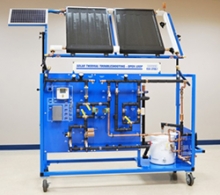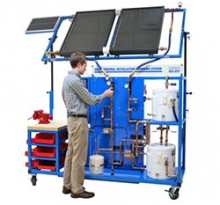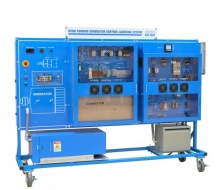Amatrol Solar PV Troubleshooting Learning System
Installing and maintaining solar photovoltaic (PV) systems requires hands-on skills and troubleshooting ability across the types of PV systems commonly used such as AC, DC, and grid-connected. Budding engineers and designers need to understand the technologies used in these systems as well.
Amatrol’s 950-SPT1 Solar Photovoltaic Troubleshooting Learning System allows students to develop the specialized skills and knowledge needed for working with the common types of PV systems. The 950-SPT1 teaches students connection, operation, programming, and troubleshooting of AC/DC and grid-connected systems. The curriculum is PC-based multimedia that is highly interactive. It allows students to use the learning style best for them – reading, listening, visual. The 950-SPT1 supports the NABCEP (North American Board of Certified Energy Practitioners) test for Certified Solar Photovoltaic System Installer.
The 950-SPT1 includes all components needed to develop hands-on, job-ready skills: all solar-specific components as well as the balance of system items. The learning system contains a mobile workstation, component panels with breakers, combiner box, MPPT charge controller, lamps, batteries, meters, grid-connected inverter, a fault insertion system, PC-based multimedia student curriculum, and instructor’s assessment guide. The required 95-SPA1 two-panel array provides a complete solar PV troubleshooting experience.
Computerized Fault Insertion
At the heart of a technician’s skill set is the ability to troubleshoot a system. The 950-SPT1 is equipped with a wide array of electrical faults that allow instructors to replicate realistic system and component failures. For the 950-SPT1, Amatrol uses electronic fault insertion so that instructors can easily insert faults and track the student’s troubleshooting results. Electric fault insertion prevents component damage while allowing instructors to see student progress. Instructors can identify specific areas the student needs to improve and target those areas. It also allows instructors to set-up faults ahead of time, allowing students to perform self-directed study when appropriate.
Balance of System Components – Replicates Real World PV System
Developing installation and troubleshooting skills for PV systems requires all the components commonly found in these systems. Elements included on the 950-SPT1 such as power distribution panels, a combiner box, disconnects, and circuit breakers are essential to create realistic systems and troubleshooting situations.
Grid-Connected and Micro Inverters
Solar applications are increasingly including grid-connected capability. In fact, grid-connected is the most common type of PV system being purchased today. This is a key component that allows maximum economic return – owners can sell excess power to the utility. Likewise, when solar power is not sufficient, additional power is often needed from the electrical grid.
Amatrol’s 950-SPT1 includes a micro inverter in addition to the grid-tie inverter. This is also a very popular option that is frequently used to assign an inverter to each PV string. Both of these inverters are required to teach skills across all major types of AC systems including stand-alone AC, grid-connected AC, and grid-connected AC with storage.
Modern Communications and Programming
Modern solar technology installations frequently include network communications. The inverters and charge controller on Amatrol’s Solar PV Troubleshooting enable students to learn how to network system components. Students also learn how to troubleshoot at the system level as well. The inverter and charge controller feature many modern programming capabilities which allow students to learn how to program the more sophisticated systems they are likely to encounter.
Mobile, Multiple PV Panels
(Required 95-SPA1 Solar PV Array Station)
The required PV array for the 950-SPT1 contains multiple panels so that students can learn to connect a realistic array. Most solar technology applications have multiple panels. Students need to learn about the effects of series and parallel connections, which require more than one panel. Additionally, the 95-SPA1 Solar PV Array Station is mobile, allowing instructors to take advantage of sunny days without having to move the entire trainer. The array is equipped with sun simulation as well to enable indoor use.
Multimedia Curriculum Available
Amatrol’s unmatched multimedia utilizes text, audio, and stunning 3D animations that engage learners in both theoretical knowledge and hands-on skills. This thorough, exceptionally detailed curriculum is built to begin with the basics and steadily advance to more complex concepts and skills. Through partnerships with key industry leaders and leading edge educators, Amatrol developed the right balance of knowledge and applied skills needed to train learners to work in their chosen field.
Student Reference Guide
A sample copy of this course’s Student Reference Guide is included with the learning system. Sourced from the multimedia curriculum, the Student Reference Guide takes the entire series’ technical content contained in the learning objectives and combines them into one perfect-bound book. If you would like to inquire about purchasing additional Student Reference Guides for your program, contact your local Amatrol Representative for more information.
Product Options
Solar PV Troubleshooting Multimedia (M20104)
Solar PV troubleshooting teaches installation and maintenance of solar photovoltaic (PV) systems across the types of PV systems commonly used such as AC, DC, and grid-tie. Learners develop the specialized skills and knowledge needed for solar PV systems, including connection and operation of the many types of solar PV systems, programming or configuring inverters and charge controllers, sizing systems and components, analyzing performance, and troubleshooting problems system wide. It supports the knowledge needed for the NABCEP (North American Board of Certified Energy Practitioners) test for certified solar PV system installer. Solar PV troubleshooting covers PV module performance, PV array connection, solar batteries, DC & AC solar PV systems, charge controllers, PV inverters, grid-tie systems, energy conservation and demand, and component sizing in addition to system level problem solving.
Engaging Multimedia
Amatrol’s extensive, thorough multimedia covers green energy themes such as solar PV troubleshooting. Interactive screens paired with instructive graphics teach an array of solar PV troubleshooting topics from PV module operation to AC solar PV systems. With the optional hardware, learners can then apply this theoretical knowledge to immediate hands-on skills. For example, learners study the operation of battery banks and then on their own calculate battery bank output given a series/parallel bank schematic for applied practice. This combination of theory and practice ingrains concepts in a learner’s mind and makes more advanced topics easier to comprehend. (References 950-SPT1)
Key Features
- Strong Depth and Breadth of Content
- Engaging Interactions
- Stunning 3D Animations
- Text and Audio
- Built for Self-Paced Learning
Learning Topics
- Module Operation
- PV Module Performance
- PV Array Connection
- Solar Batteries
- DC Solar PV Systems
- Charge Controllers
- AC Solar PV Systems
- PV Inverters
- Grid-Connected Systems
- Energy Conservation & Demand
- Solar PV System & Component Sizing
- Solar PV System Performance
- Troubleshooting Components
- System Troubleshooting
- PV Maintenance
Solar Concepts Learning System (950-SC1)
Solar energy is being used in a broad range of applications across industry and residences alike. From heating water for home use to creating utility scale electricity – solar energy application is growing. Understanding the basics of how we can harness solar energy is essential for technicians, engineers, installers, designers, builders, and others who want to apply solar technology either professionally or personally.
Amatrol’s 950-SC1 Solar Concepts Learning System introduces students to a broad range of basic concepts in solar energy and technology. Photovoltaic and thermal solar systems are introduced to students. They learn how to translate location, sun, and technology into practical applications. The 950-SC1 acts as a foundation for students in solar technology. Solar Concepts includes student curriculum in PC based, interactive multimedia format as well as an instructor’s assessment guide.
Interactive, Engaging Multimedia
Amatrol’s interactive multimedia provides an engaging, stimulating experience for students. The Solar Concepts Learning System includes interactive computer-based instruction with both theory and hands-on tutorials consisting of text, digital video, voice, online self-review tests, interactive simulations, color diagrams and color photos. Amatrol’s strong interactive multimedia includes visual, auditory, and text based learning styles to reinforce each other in well organized learning segments.
Using Solar Technology to Capture Solar Energy -Location Makes a Difference!
Siting a solar array or understanding how much energy you can capture from an array in a specific location requires background provided by Amatrol’s Solar Concepts. The type of application also plays a strong role. With the 950-SC1, students learn how to site an array with optimum orientation as well as determine the insolation, which varies significantly from place to place.
Optional 95-SIP1 Solar Instruments Package
The 950-SC1 Solar Concepts Learning System teaches students to use a variety of instruments required to apply solar technology. These virtually developed skills can be reinforced with hands-on application through the optional 95-SIP1 Solar Instruments Package. The package contains a pyranometer, global positioning system (GPS), inclinometer and compass. Students will learn how to translate their virtual skills to the actual instruments and apply them to solar technology systems. All of these are required to properly orient arrays.
Student Reference Guide
A sample copy of this course’s Student Reference Guide is included with the learning system. Sourced from the multimedia curriculum, the Student Reference Guide takes the entire series’ technical content contained in the learning objectives and combines them into one perfect-bound book. If you would like to inquire about purchasing additional Student Reference Guides for your program, contact your local Amatrol Representative for more information.
Learning Topics
- Insolation Data
- Array Orientation
- Sun Path
- Solar Time
- Global Positioning
- Peak Sun
- Solar Irradiance
- Space Heating & Cooling
- Passive & Active Water Heating
- Solar Industry
- AC & DC Photovoltaic Systems
- Solar Energy Systems
Key Features
- Interactive, Engaging Multimedia
- Using Solar Technology to Capture Solar Energy
- Optional 95-SIP1 Solar Instruments Package
Key Features
- Convenient Indoor / Outdoor Use
- Real World Components: Multiple Panel Array and Modern Communications
- Grid Interactive and Data Acquisition Options
Learning Topics
- Safety
- Solar Panel Operation
- Solar Panel Performance
- PV Array Connection
- Wind Turbine Operation
- Wind Turbine Performance
- Wind Turbine Connection
- Solar/Wind Batteries
- Charge Controllers
- Inverters
- Balance of System Components
- AC/DC Solar Systems
- AC/DC Wind Systems
- Energy Conservation and Demand
- System Performance









